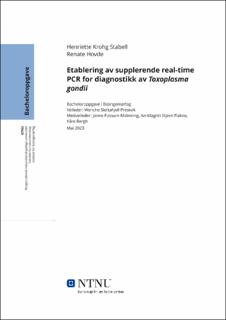| dc.contributor.advisor | Fossum Malmring, Janne | |
| dc.contributor.advisor | Stjern Flakne, An-Magritt | |
| dc.contributor.advisor | Bergh, Kåre | |
| dc.contributor.author | Hovde, Renate | |
| dc.contributor.author | Stabell, Henriette Krohg | |
| dc.date.accessioned | 2023-07-01T17:22:08Z | |
| dc.date.available | 2023-07-01T17:22:08Z | |
| dc.date.issued | 2023 | |
| dc.identifier | no.ntnu:inspera:146722497:148998066 | |
| dc.identifier.uri | https://hdl.handle.net/11250/3075190 | |
| dc.description.abstract | Toxoplasma gondii er en parasitt som forårsaker sykdommen toxoplasmose. Sykdommen er sjelden klinisk alvorlig blant friske individer, men for immunsupprimerte og gravide kan sykdommen være kritisk. Korrekt diagnostisering er derfor viktig. Toxoplasma gondii kan detekteres ved real-time PCR med to ulike målseter; multikopisekvensen Rep529 og multikopigenet B1. Ved Avdeling for medisinsk mikrobiologi ved St. Olavs Hospital, utføres real-time PCR av Toxoplasma gondii med primere rettet mot Rep529-sekvensen. Formålet med denne bacheloroppgaven var å undersøke to ulike primerpar, rettet mot B1-genet, for å finne et som er anvendelig til supplerende real-time PCR for deteksjon av parasitten.
To PCR-assay, «T. gondiii B1 AMM» og «T. gondii B1 Gomez», med to ulike primersett rettet mot B1-genet, ble testet. Til deteksjon ble TaqMan-prober benyttet. Det ble undersøkt hvilken annealingtemperatur som var mest optimal for de ulike PCR-assayene, og PCR-produktene ble analysert ved kapillærelektroforese for å detektere eventuelle uspesifikke PCR-produkter. Det ble dessuten gjennomført effektivitetsanalyse, og spesifisitetsanalyse ved hjelp av et bakteriepanel, samt bestemmelse av PCR-assayenes deteksjonsgrense. Femten positive pasientprøver ble analysert. I tillegg ble pasientprøver negative for Toxoplasma gondii analysert, for å se om humant DNA kan innvirke på effektiviteten til PCR-analysen. Til slutt ble assayene analysert på et QCMD-kontrollpanel for å undersøke assayenes evne til å utgi korrekte resultater.
Resultatene viste at begge assayene detekterte parasitten, og spesifisiteten var god. Det ble vist at AMM-assayet ga uspesifikke PCR-produkt med humant DNA til stede. Begge assayene hadde god effektivitet, og ved analyse ble det vist at Gomez-assayet hadde en lavere deteksjonsgrense enn AMM-assayet. Ved analyse av QCMD-panel ga assayene alt i alt svært like resultater, mens resultatene fra analyse av positive pasientprøver viste at AMM-assayet ga flere falske negative resultater enn Gomez-assayet.
Basert på våre resultater må det utføres flere analyser før et av PCR-assayene kan tas i bruk i diagnostikken. | |
| dc.description.abstract | Toxoplasma gondii is a parasite of which causes the disease called toxoplasmosis. The disease is rarely clinically severe among healthy individuals. However, the disease may be critical for immunosuppressed patients and pregnant women. Therefore, it is important to diagnose correctly. Toxoplasma gondii can be detected by real-time PCR, with two different target seats; the multicopy sequence Rep529 and the multicopy gene B1. At the Department of Medical Microbiology at St. Olavs Hospital, real-time PCR is performed with primers directed against the Rep529-sequence. The purpose of this bachelor’s thesis was to try out two, new primer pairs, targeting the B1-gene, to find an applicable pair for supplementary real-time PCR for detection of the parasite.
Two PCR-assays titled “T. gondii B1 AMM” and “T. gondii B1 Gomez”, with two different primer pairs directed against the B1-gene, were tested. TaqMan probes were used for detection. The optimal annealing temperature of the assays was tested, and the PCR-products were analyzed by capillary electrophoresis, to detect any non-spesific PCR products. Furthermore, an investigation of the effectiveness of the assays was carried out, and a bacterial panel was examined to look at the specificity of the assays. Determination of the assays’ detection limit was also carried out. Fifteen positive patient samples were analyzed. Additionally, patient samples negative for Toxoplasma gondii were analyzed to see if human DNA can affect the efficiency of the PCR reaction. Finally, the assays were analyzed on a QCMD control panel to investigate the assays’ ability to produce correct results.
The results from the analyses showed that both assays detected the parasite, and the specificity was good. It was shown that the AMM-assay formed non-specific bonds when human DNA is present. Both assays showed good efficiency, and the Gomez-assay showed a lower detection limit than the AMM-assay. The assays’ results on the QCMD-panel were quite similar, while the analyzing of positive patient samples showed that the AMM-assay produced more false negative results than the Gomez-assay.
Based on our results, several analyzes must be performed before one of the PCR assays can be used in diagnostics. | |
| dc.language | nob | |
| dc.publisher | NTNU | |
| dc.title | Etablering av supplerende real-time PCR for diagnostikk av Toxoplasma gondii | |
| dc.type | Bachelor thesis | |
